PE Homework - The only Two Questions Worth Asking
Since I have been a teacher, qualifying in 1999, guidance on how to set high-impact home learning has been exceptionally limited. I have followed various protocols in different schools, even written strategies for others, but I have almost never received bespoke, intelligent principles on home home learning should be considered. Furthermore, every system I have worked in has been prescriptive. What I mean by this is that I, and often my teams, have had to follow centralised protocols that are based on non-specific rules.For example:
- Students should do 1 hour per-subject per week.
- Students should receive one task per week.
- Students should be given 7-days to complete homework tasks.
Trying to make these “fit” and, specifically, “fit the way human beings actually learn, remember and forget” has often been very difficult and this has had negative connotations on the potential impact that homework can have.
So, with these slight grumbles in mind, I want to share with you the only two questions (and prompts) that I value with regard to homework. The aim of presenting this to you is to try to help to simplify your approach to homework but, more importantly, to cause greater impact of the time that a teacher will spend setting and reviewing homeworks.
Let’s get started:
The two questions you should ask are:
- When is the homework occurring?
- What is the teacher to student ratio of time contribution to the task?
So, before I show you a range of examples, I want to spend time on each question.
The “WHEN” question may not be what you are anticipating it to be. WHEN? Means, when in relation to the associated lesson rather than when in the week, say.
Let’s take an example. Let’s say that you see your group twice a week on a Tuesday afternoon and Thursday morning. This means that you have two reference points for the WHEN question. Let’s go further and say that your Thursday lesson tends to be used for practical and other NEA learning (I do not do this btw - see my future post on this theme). This is how I would be thinking about the WHEN question:
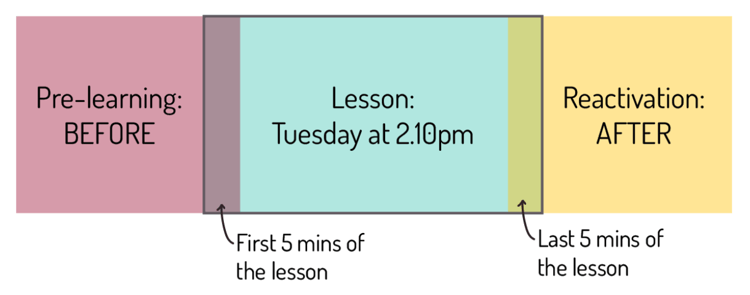
So, the first premise is to ask when are students developing knowledge and skills at home in relation to the timing of your lesson? Is it before the lesson? If so, what is the purpose of this? Is it after the lesson? If so, what is the purpose of this?
So, whilst I am advocating directly for the WHEN? Question, I want to give my opinions on the purposes of pre-learning and reactivation.
Take a look at this example of me teaching antagonistic pairs and types of contractions in AQA GCSE PE:
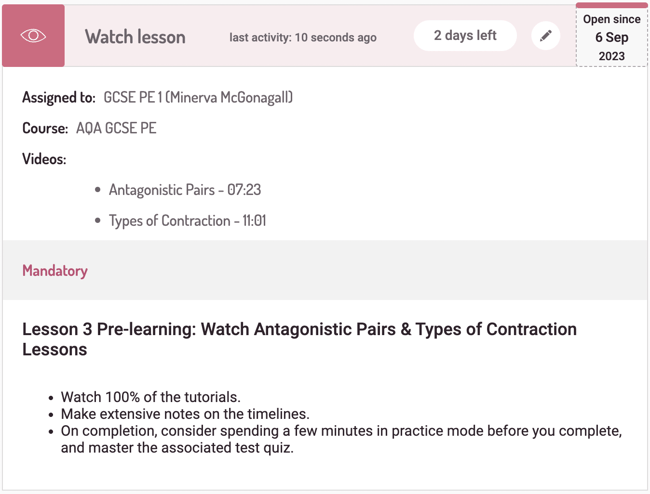
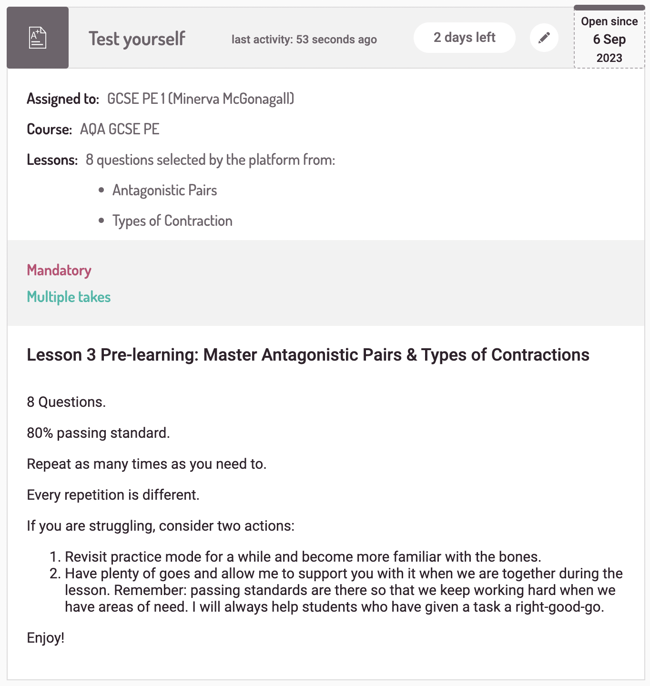
*Homeworks set on TheEverLearner.com
These two tasks clearly promote the idea of pre-learning but, crucially, are assessed absolutely objectively with no work required by the teacher beyond the setting. For example, the video tutorial viewing is tracked under these rules:
- Each millisecond of the video is tracked as an individual unit meaning that if students drag the play bar, they get no viewing credit for anything they have not watched.
- The video tutorial cannot be split-screened with another application. They are either watching the tutorial or doing something else.
- The software notices if the student does not engage with their device (perhaps they have walked away and gone to the loo). In this case, the tutorial stops and asks the student if they are present.
In summary, pre-learning can never be just sending students to a YouTube video. The tutorial needs to be consumed in an educationally-designed piece of software as does the mastery testing environment.
The outcome of this is very simple: In a given week, I am likely to set multiple bite-sized tasks and this will occur both before and after a lesson. If this breaks a homework policy, tough! I will stop doing it when, and only when, a colleague can prove to me that it is not having an impact.
Here are some examples:
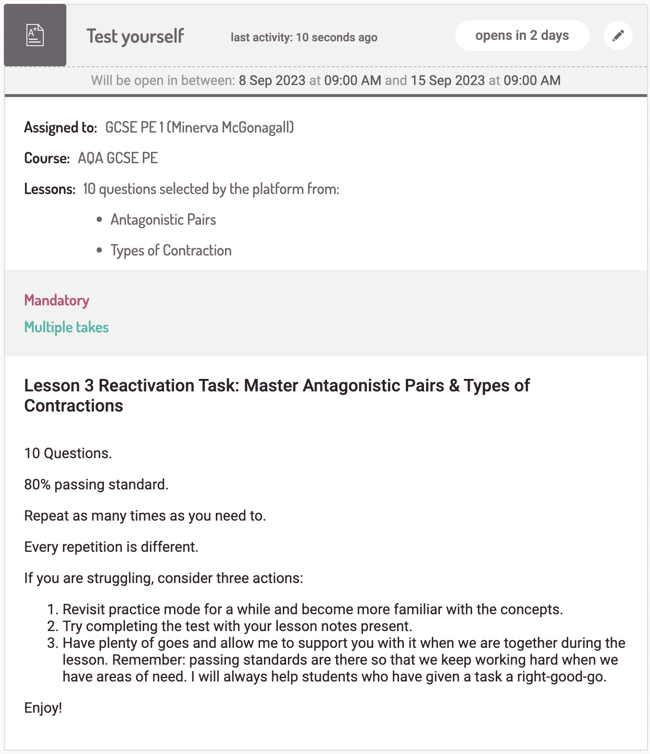
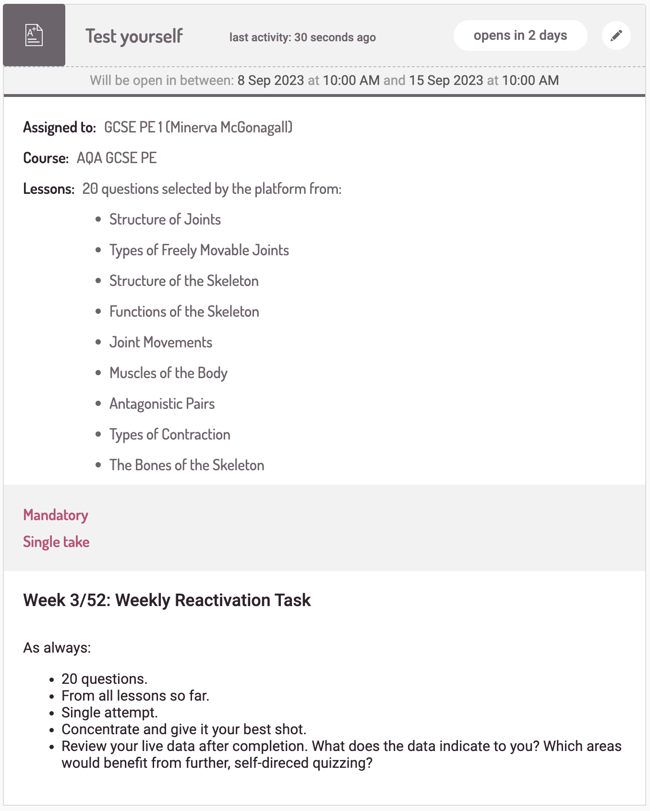
These two homeworks are reactivation tasks. They cause the student to recall their newly learned material and, in the context of the second task, do so in association with other relevant older learning.
You may have noticed in the illustration that one possible answer to the WHEN? question is during the lesson. In my opinion, great homeworks, naturally spill into the classroom. For example, if lots of progress has been made during the lesson and the lesson is coming to a crescendo, I will encourage students to start their reactivation tasks then. Furthermore, as students arrive to the class, I will already have access to the pre-learning activity and I may immediately question them on it or discuss it as they arrive. As recently as my last week of teaching (before summer hols), I taught a PE GCSE lesson that happened to be practical. After the lesson, in the changing room, a number of the students spent their last 60s before the bell completing their reactivation tasks. GREAT!
The ratio question is a little more weighty. In my experience, good quality homeworks will have a minimum of a 1:20 ratio. In fact, the ratio can be far, far higher than this.
So, what is this ratio?
The first number, the 1, relates to the total minutes spent by the teacher setting, marking and reviewing the homework. So, if you spent exactly 1 minute doing this, then the minimum activity time per student should be 20 minutes. Likewise, if the teacher were to spend 10 minutes, the student activity time should be 200 minutes. Now, I should add that I never, ever spend more than two minutes per week setting, marking and reviewing a homework. Therefore, students are quite likely to spend about 40-minutes per week doing homework for my class. Perfect!
Let’s take an example:
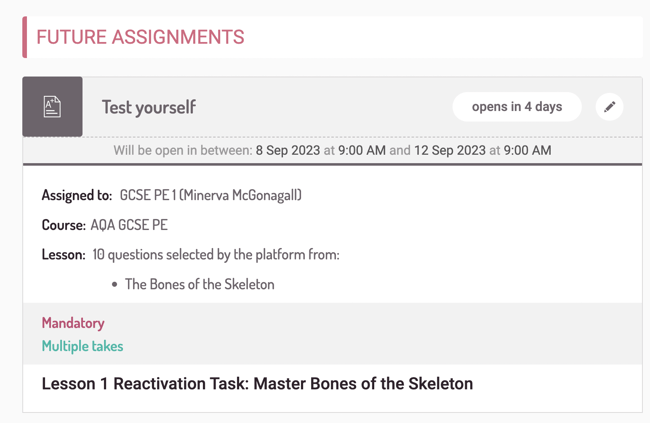
The task in this image above took me about 30s to set (I should add that I have quite a regime of homeworks so setting them is super quick). It is a 10 question mastery test on bones and associated topics and this will take the students in the region of 5 minutes to complete one run. However, the task has a mastery standard of 80% minimum so, on average, I would expect each student to complete three runs (each run is different). This means that, on average, students will spend about 15 minutes on this task giving us a ratio of 0.5:15 or 1:30. Perfect!!
The issue with so many homeworks that I have seen is that teachers end up doing the vast majority of the activity. They write questions, set tasks, manage handouts, take-ins and then mark pieces of work. Why? I mean, really… why? I believe that one of the answers to this question is that homeworks too frequently involve higher level skills such as exam answering or essays etc… Whilst I don;t rule this out by any means, it is fair to say that I want my students doing the hardest tasks (often exams, extended writing, essays etc…) in my presence, not when they are at home without support. Therefore, my homework tasks are often based on the fundamentals:
- Learn it!
- Understand it!
- Remember it!
- Recall it under pressure (time pressure or needing to discriminatively contrast it from other areas of learning)!
You will see this theme in all of the examples I have given in this post.
Conclusion
So, colleagues, I wish to make a plea to you: Please, please challenge the idea of homeworks in your classrooms and departments. The two principles I have made reference to here will, I believe, improve the impact of homeworks in any classroom.
- Establish When the homework is occurring in relation to your lesson(s).
- A minimum of a 1:20 teacher to student ratio of time contribution to the task.
Maybe, just maybe, this is the only homework policy a teacher/department/school actually needs.
Thank you for reading.
%20Text%20(Violet).png)


